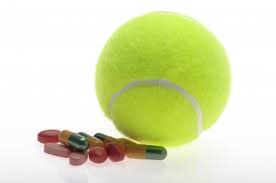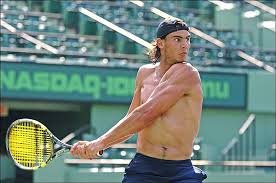A RACKET WITH NO NET

Tennis exists in a cosy world of big money, good looks and high performance that’s left everyone smiling. But behind this, the carry on of the sport suggests there’s a dark and dirty secret, writes Ewan MacKenna
Perhaps it was the early hours that were playing tricks. It was near rising time for everyone else yet you were still sunk into the sofa, all because of a game of tennis. Andy Murray was playing his best match in an age but across the court, facing Novak Djokovic, he might as well have been hitting against a wall. In a weak moment, that US Open quarter-final had you thinking this was the greatest era the sport had known.
As day broke back in August, maybe it was light that brought sense along with a line in a Telegraph blog about Murray. “He heartbreakingly couldn’t quite match the ridiculous endurance levels of Djokovic.” Whether it was a veiled comment we’ll never know, but we do know the world number one is tender to talk about his use of a pressure chamber whose chief executive says may be twice as effective at helping the body absorb oxygen as blood doping, and of which Wada said was “against the spirit of the sport”. This after Djokovic admitted on route to winning the 2013 Australian Open that he hadn’t been drug tested in six months.
This is not to accuse Djokovic himself, but it does raise major questions about the reality of tennis for behind the good looks, charm and a sitcom feel to the entire circuit are doubts so dark they blacken the illusion. The reality is this is a cosy little club where media get access and everyone else gets rich. As one prominent tennis writer says, “For some reason most tennis journalists don’t want to know about drugs in their game”.
A few years back, after the remarkable work done by Paul Kimmage and David Walsh in cycling, it became popular to call out every sport without so much as a warning light on the dash. But with tennis, there’ve long been flames melting the bonnet. Athletes across comparable sports have been found to repeatedly dope so why would it be different? Tennis players have the same motives of wealth and fame and the same opportunities through a weak testing regime, so to think they’ve fortified morals because they’re likeable is to be blind. At this point meet head of tennis testing, Stuart Miller.
He’s on record as saying, “You can’t be a great player without a significant amount of skill, and that in itself helps tennis be a little more confident there isn’t widespread abuse… It may be that tennis is not conducive to EPO… Maybe tennis is not a sport that is driven by a need to maximize stamina… Tennis is not obviously lending itself to a particular category of performance-enhancing products”.
But there are two ways to be fooled. One is to believe what isn’t true; the other is to refuse to believe what is true. So here is a sport where huge advantages are accorded by upper-body power and where there’s a need for huge endurance and explosive bursts across consecutive hours and days. Stamina can equal EPO. Strength can equal anabolic steroids. Recovery can equal testosterone. Agility can equal stimulants. Little wonder, when asked if he knew how widespread doping was in tennis, former Wada President John Fahey said: “No I don’t and nor do I think tennis knows how widespread it is.” Little wonder Roger Federer said: “Naivety says that tennis is clean.” Little wonder Jo-Wilfried Tsonga said: “I just don’t know who I believe anymore. Everybody is lying.”
There is a history here. John McEnroe admitted to corticosteroids. Andre Agassi revealed he tested positive for meth in 1997, but convinced the governing body he’d sipped his assistant’s spiked soda. By 1999 Jim Courier said there was an EPO problem. And in 2002 and 2003, Greg Rusedski was one of eight with illegal nandrolone levels but charges were quashed and six others were never named. But these aren’t just old school issues.
Serena Williams wasn’t tested across 2010 or 2011 yet finally, in October 2011, when testers went to her house she fled to her panic room saying she thought it was a robber. No test was subsequently conducted. Cocaine may not be performance enhancing but it has pointed to system flaws. In 2009, Richard Gasquet was cleared of using the drug because he kissed a woman who’d taken it. Rafael Nadal supported his defence but he’s been dogged by accusations too. This year, former pro Christopher Rochus commentating during the Australian Open said the Spaniard was faking injury to return to the locker room to “get a shot”. It wasn’t his first attack on a player that has drawn huge attention for his cycles of dominance followed by bizarre injuries followed by a superhuman ability to bounce back from problems with key areas like wrists and knees.
But there’s so much more. In 2012, Luis Garcia del Moral was banned by the US Anti-Doping Agency after affidavits from Lance Armstrong’s former teammates said he’d drawn up doping plans, supplied EPO, testosterone, HGH and cortisone, and did blood transfusions while at cycling’s US Postal. Yet he’d also been working at the TenisVal Academy for over a decade and that same year after rocketing in the rankings, Sara Errani said he was the best doctor in Valencia so of course she worked with him while Dinara Safina raved about his work. Nothing came of this nor did anything come of the sport being linked to the Biogenesis investigation in America. In these cases, do you believe doctors doped athletes in other sports but not their tennis clientele?
The International Tennis Federation’s silence just adds to the noise. If a player tests positive, it’s only made public when a ban is handed down, meaning an appeal can overturn results and we never know the who, what, where, when, how or why. Between 2007 and 2011, the ITF reported 53 positives but only 21 anti-doping violations and never explained the anomaly. True, testing has increased with the recent introduction of biological passports, but in terms of improvements, you can only go up from bedrock.
That’s where ITF testing lay low a handful of years ago. For instance, figures compiled by the superb ‘Tennis Has a Steroid Problem’ website show that between 2006 and 2011 there was a 33 per cent reduction in blood testing, in 2008 just 20 EPO tests took place, and by 2012 there were only 63 out-of-competition blood tests. But with more funding and more scrutiny come more queries. Does quantity equal quality, why no figures to show if testing has switched to winner-targeted, where are key statistics once readily available? For all the talk, we aren’t allowed see the walk.
Next Sunday the men’s tour finale starts in London after another season of the same. All year tennis stars brilliantly played each other. But the question remains who amongst them played the rest of us as well?
Sunday Business Post
2 November, 2014
2 November, 2014





No comments:
Post a Comment